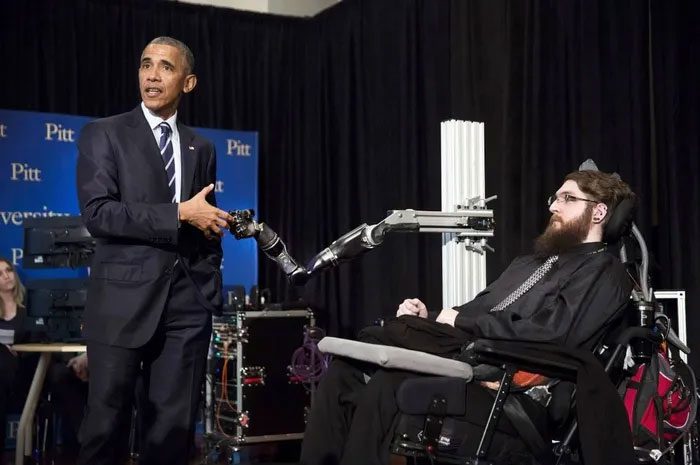Brain implant devices can intervene in the human brain and cause certain effects, but they cannot manipulate psychology, thoughts, or emotions.
The aggressive bull stopped suddenly, its hooves digging deep into the ground, less than a meter away from José Manuel Rodriguez Delgado. Delgado was not a bullfighter; he was a Spanish neuroscientist conducting a daring experiment.

Mind control is a common theme in science fiction movies, sometimes using modern technological devices. (Photo: Inverse).
He conducted this experiment in 1963 to demonstrate that he could control violent behavior. As the bull charged, Delgado pressed a switch on a handheld remote, activating electrodes that had been previously implanted in the bull’s brain.
Since then, psychological manipulation and brain intervention through implantable devices have become a topic that is both fascinating and concerning.
Billionaires like Elon Musk and Mark Zuckerberg are pouring millions of dollars into developing brain-computer interface (BCI) technology. Musk aims to create a layer of superintelligence “add-on” in the human brain, while Zuckerberg wants to enable the uploading of thoughts and emotions to the Internet.

A monkey implanted with a brain chip plays video games without a hand controller in an experiment by Neuralink, Elon Musk’s company. (Photo: Neuralink).
However, this is also a topic where the line between reality and fiction is not clear. Just how capable are today’s technologies in influencing the human brain?
Intervening in the Brain
Since 1964, Delgado’s technology has achieved remarkable effects on the brain. Simply by applying electrical stimulation to the brain through previously implanted electrodes, this technology can suppress ongoing brain activity or induce states of excitement or despair.
Thus, it is no surprise that many people fear that at some point, more advanced technologies will be able to completely manipulate human psychology and thoughts.
Renowned neuroscientists have also expressed concerns. An editorial published in 2017 in the leading scientific journal Nature opened with a hypothetical scenario reminiscent of an episode of Black Mirror. A paralyzed man is implanted with a device to control a prosthetic arm. One day, due to psychological stress, the implanted device goes haywire and uses the prosthetic arm to attack someone.
However, such scenarios, or the mind-manipulating technologies in Black Mirror, are purely fictional.
With technology more advanced than in 1964, neuroscientists today can apply electrical stimulation to certain areas of the brain to attempt to produce specific desired effects.
For instance, a study published in Nature Neuroscience in August described how electrical stimulation to a region at the front of the brain helps improve long-term memory, while stimulation to a region located at the back and deep within the brain enhances short-term memory.

Nathan Copeland controls a robotic arm to shake hands with former President Obama. (Photo: Wired).
Implanting electrodes into the motor cortex can also help paralyzed individuals control a robotic arm or computer cursor simply by thinking. One patient who received this intervention, Nathan Copeland, was able to control a robotic arm to shake hands with former President Obama.
However, changing or “implanting” a thought or emotion remains impossible. This is because neuroscientists still do not understand how thoughts, emotions, and intentions are “encoded” in the human brain and what signals they become amidst the myriad of signals continuously transmitted in the brain.
Complex Signals
The electrical activity that continuously fluctuates within the cortex, known as brain waves, will abruptly cease if a person moves or intends to move their hand. From this silence, scientists create brain implants that read brain waves and control prosthetics. However, understanding the continuous electrical activities occurring in the brain is an entirely different matter.
“It’s like when a noisy restaurant suddenly goes silent after someone drops a glass; we can easily interpret the silence as a clear signal of an event, but that doesn’t mean we understand the conversations around it,” explains R. Douglas Fields, a professor of neuroscience and cognitive science at the University of Maryland.
Assuming each neuron has only 2 states, “on” or “off”, the reality is far more complex. In a network of 300 neurons, there would be 2^300 possible states – more than the number of atoms in the observable universe. And the human brain contains 85 billion neurons, generating an almost infinite number of signals.
Even if we understand these signals, we still do not know which cells or combinations of neurons created the signals, making it impossible to stimulate them to produce signals differently and change a person’s emotions or thoughts.
“We can identify the brain region corresponding to a signal, but we cannot know specifically which neurons are involved. And in each individual, the neurons can differ,” says Timothy Buschman, a neuroscientist at Princeton University.
Despite significant advancements in neuroscience and brain implants, the ability to control the mind through technology remains beyond human reach.


















































